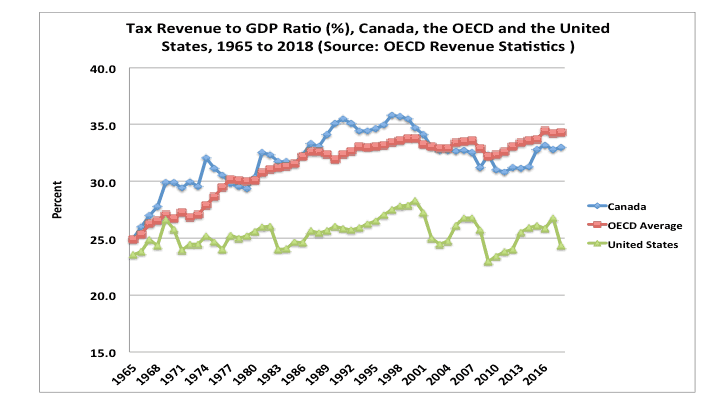Tax gap growing between Canada and the U.S.

The OECD just released the 2019 edition of its annual Revenue Statistics, which show an average total tax revenue-to-GDP ratio in 2018 for the OECD countries at 34.3 per cent—virtually unchanged from 34.2 per cent in 2017. This appears to mark an end to a trend of annual increases in the tax-to-GDP ratio that’s been underway since the financial crisis.
In 2018, eight OECD countries had tax-to-GDP ratios above 40 per cent (France, Denmark, Belgium, Sweden, Finland, Austria, Italy and Luxembourg). Meanwhile, only five OECD countries (Mexico, Chile, Ireland, the United States and Turkey) had ratios under 25 per cent with the majority of OECD countries ranging somewhere between 30 per cent and 40 per cent of GDP.
Canada, in that majority range and with an overall tax-to-GDP ratio of 33 per cent, was 23rd out of 34 OECD countries or essentially at the top of the bottom third. Some might see this as good news; that Canada is quite competitive on the international tax front. However, there are two caveats illustrated in the below chart, which plots the tax-to-GDP ratios from 1965 to 2018 for Canada, the U.S. and the OECD average.

First, our major economic competitor and the OECD country with which we have the highest degree of economic integration—the U.S.—had a substantially lower tax-to-GDP ratio of 24.3 per cent in 2018. Indeed, the gap between the two countries grew from the mid-1960s (when the tax-to-GDP ratios were almost identical) to a peak gap in the early-1990s and then shrank somewhat.
However, 2018 saw a major drop in U.S. tax revenues from 2017 due to major reforms to personal and corporate taxes. Corporate income tax revenues fell by 0.7 percentage points and personal income tax revenues fell 0.5 percentage points, and the overall tax-to-GDP ratio in the fell a larger 2.5 points, from 26.8 per cent to 24.3 per cent. Meanwhile, Canada’s rose from 32.8 per cent to 33.0 per cent.
Second, when we compare ourselves to the OECD average, our superior performance only dates back to improvements that began in the late-1990s. Until then, our tax-to-GDP ratios were often above the OECD average and came down with our tax rate reductions at federal and provincial levels since the mid-1990s. However, starting circa 2009, the tax-to-GDP ratio for the OECD average began to rise again and Canada started to follow this trend after 2014.
As we move past 2017, both Canada and the OECD average have seen the tax-to-GDP ratio gap with the U.S. grow.
Clearly, the U.S. has undertaken tax changes and reforms that will impact Canada the most of all the OECD countries, given our close economic ties with the American economy. Such a large gap will only harm the competitiveness of the Canadian economy. As we move into the new year and federal-provincial budget season, it will be important to address the competitiveness issues created by a growing tax performance gap with the United States.

